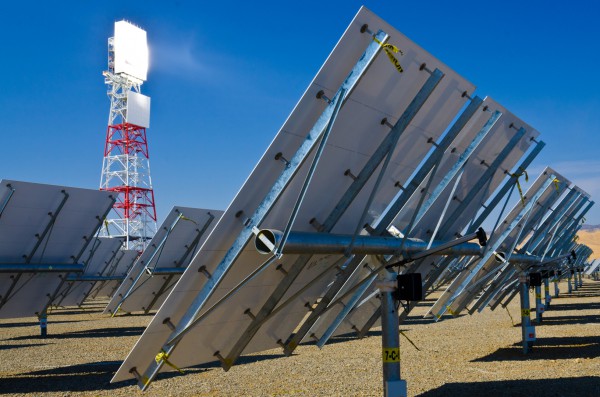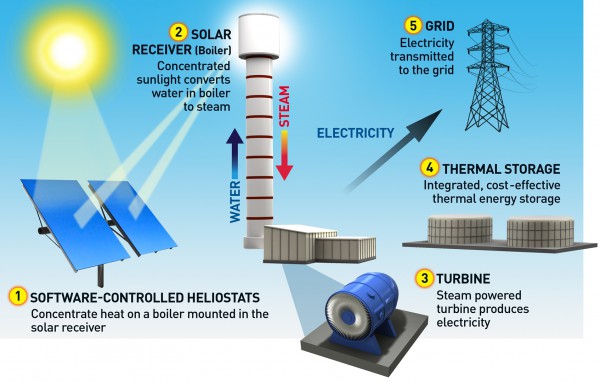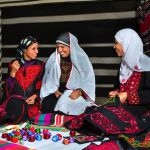“Fields will be bought for silver, and deeds will be signed, sealed and witnessed in the territory of Benjamin, in the villages around Jerusalem, in the towns of Judah and in the towns of the hill country, of the western foothills and of the Negev, because I will restore their fortunes, declares the Lord.” (Jeremiah 32:44)
The tallest solar tower in the world will soon produce one percent of Israel’s electricity needs by utilizing 50,000 computer-controlled mirrors across one square mile in the southern desert.
The mirrors (heliostats) will concentrate sunlight onto a boiler at the top of a 240-meter (787-foot) tower, heating up stored water to about 540 degrees Celsius (1,000 degrees Fahrenheit), turning it into steam. Steam turbines provided by General Electric will then generate electricity for storage and commercial output.
“Most solar power in the world is generated by photovoltaic (PV) panels, which can be installed anywhere from a roof to a backyard. In contrast, towers that use concentrated solar power, known as CSP, require a lot of land and are only cost-efficient in large-scale projects,” reports Ari Rabinovitch for Reuters.
Only five percent of solar facilities around the world are designed to utilize CSP, solar thermal energy, often because of space constraints. One such plant with three towers covering 6 square miles opened in the Mojave Desert of California in 2014, developed by power tower mogul, BrightSource Energy, a 25% shareholder of the Israeli plant.
“The Israeli desert is more than big enough for the power tower,” Eran Gartner, Mega Solar Power CEO, told Israeli news channel ILTV, adding that when operating at full capacity, the plant would provide energy “for about 120,000 homes.”
According to Megalim Solar Power Ltd., the Israeli government has promised to purchase the solar plant’s electricity output “above the market price.” (ILTV)
The project itself will cost $773 million with 80 percent of its funding forwarded by the European Investment Bank and a banking syndicate in Israel led by Bank Hapoalim.
The Megalim tower is an “important step toward the fulfillment of the objectives of the [European Union] as well as Israel’s national priority objectives relating to combating climate change and supporting renewable energy, as it will emit significantly less greenhouse gases and other pollutants than conventional thermal power plants,” states the European Investment Bank, which provided a $167 million loan for the project. (EcoWatch)
The sandy site chosen for Megalim tower is Ashalim (population 417 as of 2014), near the Ashalim kibbutz, about 35 km south of Be’er Sheva and to the east of the Nahal Besor, the Negev’s largest stream.
The Ashalim power station is expected to produce 121 megawatts (MW) of electricity “at peak power.” A second 30MW plant will offer a combined peak output of 2.5 percent of the State of Israel’s electricity needs — together reliant upon concentrated solar thermal energy, PV panels, and natural gas.
“We’re making strides in efficiency; we’re making strides in compressing the time of construction; we’re making strides in trying to merge the energy storage with energy during the daytime,” Gartner added, stating the company’s plans “to continue to improve solar energy at the most competitive rates.”
At Megalim Solar Power’s cornerstone ceremony last June 11, the company projected more than 1,000 engineers, technicians, construction workers, and support services would be hired in the course of the building project, with 45 permanent skilled workers and a grand opening slated for 2017. (Bright Source Energy)
The State of Israel also has set a goal of producing 10 percent of its energy from renewable energy sources by the year 2020, with the government seeking a 250MW increase of energy from the Negev and the Arava desert region per year. (Ecowatch)
Israel is not only focused on its own energy goals, however. In a continuous effort to repair and bless the world, Israel began discussions last month with Cyprus and Greece on connecting the Jewish state’s power grids and gas pipelines together.








